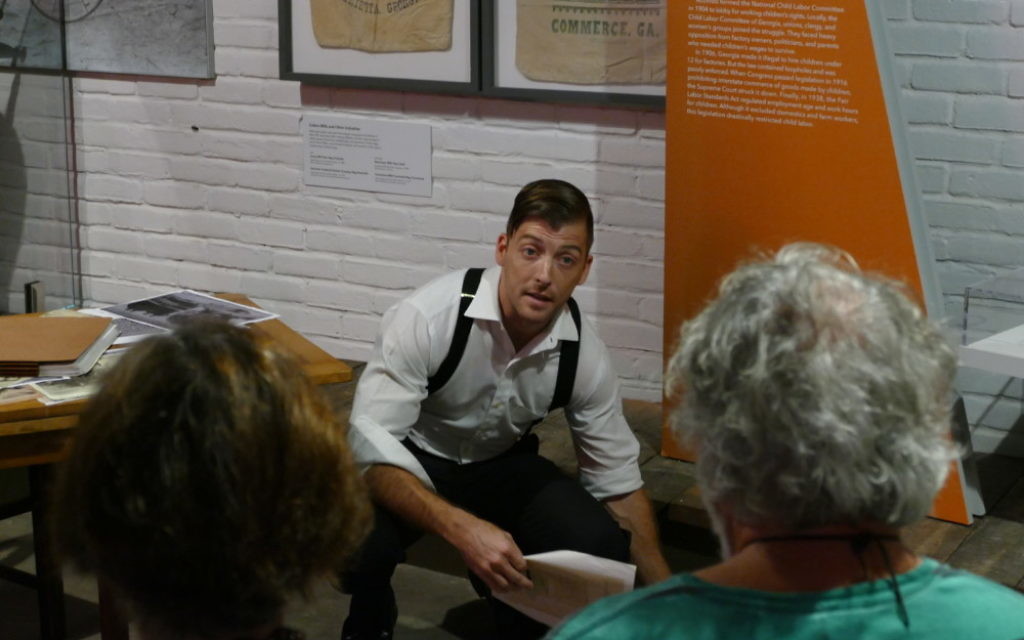How Jews Shaped Atlanta
Above: Calvin Wickham portrays Gov. John Slaton in a live “Meet the Past” performance at the Atlanta History Center’s new permanent exhibition.
The Atlanta History Center’s newest permanent exhibition is full of nods to the impact of Jews on the city’s history.
“Gatheround: Stories of Atlanta,” which opened July 2, focuses on stories of people from a variety of backgrounds who helped create the Atlanta we know today. Included in the 7,700-square-foot exhibit is a section devoted to the 1913 trial and 1915 lynching of Leo Frank, a re-creation of Jewish Holocaust survivor Eli Sotto’s barbershop, which closed in 2014 after nearly six decades, and a section detailing the bombing of The Temple in 1958.
Get The AJT Newsletter by email and never miss our top stories Free Sign Up
“You can’t tell a story about Atlanta and not talk about its Jewish citizens,” said Calinda Lee, the exhibit’s curator. “If we don’t, we won’t do it justice. Hopefully, we get that now.”
Rather than display pieces or artifacts in a chronological order, “Gatheround” is arranged by broad themes relevant to everyday life in Atlanta. Sections include Family & Community, Politics & Justice, Urban Growth and Cultural Life.
Among the sections are nearly 750 artifacts, documents, photographs and books specifically chosen by Lee to create a connection between guests and the subjects depicted to show the history of the city at large.
“I want people who see this exhibit to know that you can make a difference,” Lee said. “Your story matters, and you can do big things that actually impact the course of history.”
Special highlights of the exhibit are re-created spaces featuring live “Meet the Past” theater performances that will help visitors understand and appreciate Atlanta’s people, places and events.
Developed by Katie Whitman, the vice president of public programs, and Addae Moon, the director of museum theater, these weekend performances see actors portray notable Atlantans such as John Slaton, the Georgia governor who commuted Frank’s death sentence; Rosalyn Walton of the Atlanta Nine, one of the first students to desegregate Atlanta Public Schools; and a newsboy who recounts the Atlanta Race Riot of 1906.

Whitman said performances will be added as the exhibit continues.
Two of the “Meet the Past” acts come from Jewish Atlanta’s history. In the Leo Frank section of the exhibit, Calvin Wickham portrays Slaton as he grapples with the decision to commute Frank’s death sentence and thus kill his own political career. In Sotto’s re-created barbershop, Wickham plays a young Sotto talking about the civil rights movement with Alonzo Herndon, one of the first African-American millionaires, during a haircut.
Lee said she incorporated Sotto’s shop into the exhibit because he represents an intersection of communities in Atlanta.
“Eli Sotto has a specific story about his life as a concentration camp survivor coming to Atlanta,” Lee said. “But he also is a person who witnessed the counterculture revolution on the front steps of his barbershop. He had a sensibility as someone who had experienced grave discrimination, and that shaped his response to the civil rights movement. So there are all these connections between different communities that people can connect with in lots of ways.”
The 1958 bombing of The Temple also is prominently featured. A large photo of Rabbi Jacob Rothschild and Atlanta Mayor William B. Hartsfield kneeling in the rubble of the blast sits at the front of a collection of religious artifacts.
A large remnant from the explosion, on loan from the William Breman Jewish Heritage Museum, also is on display.
What: “Gatheround: Stories of Atlanta”
Where: Atlanta History Center, 130 W. Paces Ferry Road, Buckhead
When: 10 a.m. to 5:30 p.m. Monday to Saturday; noon to 5:30 p.m. Sunday
Tickets: $11 to $16.50; atlantahistorycenter.com/visit/tickets
Photos by David R. Cohen







comments